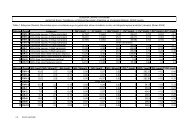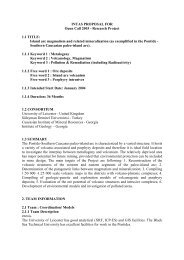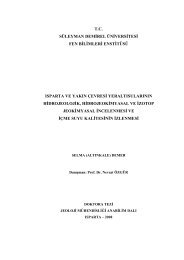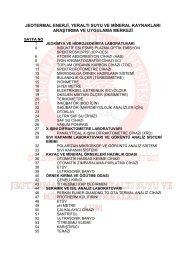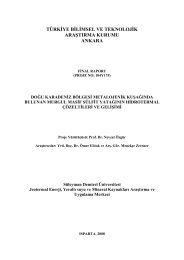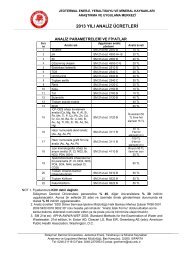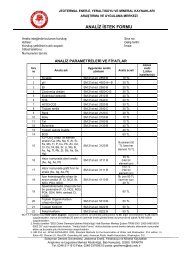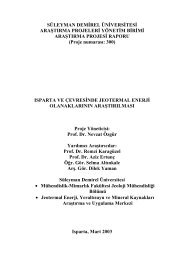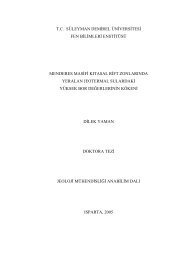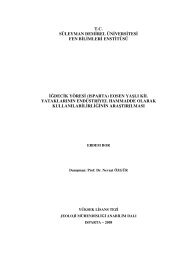pleistocene eruptive chronology of the gölcük volcano, isparta angle ...
pleistocene eruptive chronology of the gölcük volcano, isparta angle ...
pleistocene eruptive chronology of the gölcük volcano, isparta angle ...
Create successful ePaper yourself
Turn your PDF publications into a flip-book with our unique Google optimized e-Paper software.
Quaternaire, 19, (2), 2008, p. 147-156<br />
PLEISTOCENE ERUPTIVE CHRONOLOGY<br />
OF THE GÖLCÜK VOLCANO, ISPARTA ANGLE, TURKEY<br />
<br />
Bernard PLATEVOET 1 , Stéphane SCAILLET 2 , Hervé GUILLOU 2 ,<br />
Dominique BLAMART 2 , Sébastien NOMADE 2 , Marc MASSAULT 1 ,<br />
André POISSON 1 , Ömer ELITOK 3 , Nevzat ÖZGÜR 3 ,<br />
Fuzuli YAGMURLU 3 & Kamil YILMAZ 3<br />
ABSTRACT<br />
In <strong>the</strong> Eastern Mediterranean region, <strong>the</strong> Isparta volcanic belongs to <strong>the</strong> post-collisional alkali-potassic to ultrapotassic magmatism active<br />
since <strong>the</strong> Miocene in this part <strong>of</strong> <strong>the</strong> Anatolian peninsula from Afyon to Isparta. In <strong>the</strong> so-called Isparta Angle (IA) <strong>the</strong> magmatism is<br />
contemporaneous with an extensional regime intiated during Late Miocene and active throughout <strong>the</strong> Pliocene and Quaternary. Previous K/Ar<br />
dating performed on lavas suggested that potassic-ultrapotassic magmatism occurred between 4.7 to 4 Ma. However, a more recent (Quaternary)<br />
activity <strong>of</strong> <strong>the</strong> Gölcük <strong>volcano</strong> is evidenced by <strong>the</strong> present-day morphology and field evidence although it remained undated and poorly studied so<br />
far. Field mapping and new radiometric data indicate that <strong>the</strong> main <strong>volcano</strong>-forming stages <strong>of</strong> <strong>the</strong> Gölcük <strong>volcano</strong> consist <strong>of</strong> three main <strong>eruptive</strong>s<br />
cycles. (1) Cycle I, represented by more than 200m-thick pyroclastic flow deposits occasionally separated by paleosoils and corresponding to<br />
caldera-forming ignimbritic eruptions. (2) Cycle II, consisting <strong>of</strong> tephriphonolite lava dome-flows extruded throughout <strong>the</strong> caldera and currently<br />
found along <strong>the</strong> rim <strong>of</strong> <strong>the</strong> present crater. (3) Cycle III made up <strong>of</strong> tuff-ring deposits related to several phreatoplinian eruptions <strong>of</strong> a maar-type<br />
volcanic activity. This youngest cycle ends with trachytic domes protruding within <strong>the</strong> maar crater. Unspiked 40 K/ 40 Ar dating on mesostasis was<br />
performed on lavas (tephriphonolites and trachytic domes), and complemented by preliminary 40 Ar/ 39 Ar data on tephra deposits (sanidine). Our<br />
preliminary results show that <strong>the</strong> entire activity <strong>of</strong> Gölcük <strong>volcano</strong> took place during <strong>the</strong> Pleistocene and was disconnected from <strong>the</strong> older Pliocene<br />
volcanism. This volcanic activity can be considered as a new volcanic cycle, starting (Cycle I) around 200 ka with major explosive, regional-scale,<br />
events represented by at least six ignimbrites sheets. Cycle II occurred between 115 ± 3 ka to 62 ± 2 ka with probably some associated tephra<br />
deposits. Tuff-ring <strong>of</strong> Cycle III formed from 72.7 ± 4.7 ka to 24 ± 2 ka. The associated phreatoplinian eruptions have almost entirely destroyed <strong>the</strong><br />
previously formed flow-dome. This latest activity corresponds to several volcanic crises as illustrated by <strong>the</strong> two domes protrusions separated by<br />
about 30 ka. The volcanic history <strong>of</strong> Gölcük ceased around 24 ka ± 2 ka, but <strong>the</strong> periodicity <strong>of</strong> <strong>eruptive</strong> events appears to be long and complex.<br />
Currently, <strong>the</strong> <strong>volcano</strong> is at rest, but <strong>the</strong>re is no doubt that <strong>the</strong> Isparta town (more than 120 000 people) built on top <strong>of</strong> <strong>the</strong> most recent tephra falls is<br />
exposed to a major volcanic hazard in <strong>the</strong> future.<br />
Key-words: alkaline volcanism, tephra, ignimbrite, pyroclastite, 40 Ar/ 39 Ar, K/Ar, 14 C dating methods, volcanism hazard, Gölcük, Isparta Angle,<br />
Turkey.<br />
RÉSUMÉ<br />
CHRONOLOGIE DES ÉPISODES VOLCANIQUES PLÉISTOCÈNE DU VOLCAN GÖLCÜK, ANGLE D’ISPARTA, TURQUIE<br />
En Méditerranée Orientale, la région active d’Isparta est le siège d’un magmatisme alcalin lié à la distension affectant cette partie de la<br />
Péninsule Anatolienne depuis le Miocène supérieur. Le volcanisme Pliocène est alcalin et très potassique, depuis des magmas lamprophyriques à<br />
lamproïtiques, jusqu’à des téphriphonolites et des trachytes. La construction du volcan Gölcük au sud d’Isparta marque le début d’un nouveau cycle<br />
éruptif après une longue période d’arrêt et d’érosion. L’étude morpho-structurale du volcan couplée aux datations 40 K/ 40 Ar sur lave et 39 Ar/ 40 Ar sur<br />
monograin de feldspath-K indique une histoire éruptive complexe, nettement plus jeune que l’activité antérieure (Pliocène). Ces résultats<br />
préliminaires montrent que l’activité volcanique du Gölcük est située dans le Pléistocène supérieur (Paléolithique) entre environ 200 ka et 24 ka.<br />
Trois cycles volcaniques majeurs sont reconnus : (1) Cycle I débutant vers 200 ka avec des éruptions ignimbritiques majeures avec un ensemble de<br />
coulées pyroclastiques trachytiques comblant les paléo-vallées ouvertes dans les formations sédimentaires et les formations volcaniques d’âge<br />
pliocène ; (2) Cycle II avec un épisode effusif de faible importance succède entre 115 ± 3 ka et 62 ± 2 ka à l’activité explosive initiale avec la mise en<br />
place d’un édifice central constitué de dômes-coulées téphri-phonolitiques ; (3) Cycle III entre 70 ka et 24 ka, l’activité devient phréatoplinienneet<br />
suit de près le cycle précédent. Le dynamisme éruptif phréatomagmatique est celui d’un maar formé d’un large cratère d’explosion entouré d’un<br />
anneau de tufs. La dernière crise volcanique se termine par l’extrusion de plusieurs dômes de trachyte dans le cratère et de téphras associés, de<br />
nouvelles coulées pyroclastiques se mettent vraisemblablement en place vers le nord-ouest. Les données de terrain et les âges 40 Ar/ 39 Ar disponibles<br />
indiquent que ces dernières manifestations (construction du maar) sont très récentes et sub-contemporaines du dernier niveau de retombées<br />
ponceuses sous les immeubles de la ville et des dômes de lave intra-caldeira. Cet âge récent est confirmé par un âge 14 C obtenu sur des bois<br />
carbonisés. La morphologie du volcan actuel est relativement bien conservée, malgré l’érosion très active qui remodèle déjà partiellement les<br />
pentes. La reprise éventuelle de l’activité du volcan constituerait un risque majeur à l’échelle de la région et en particulier pour la ville d’Isparta<br />
établie au pied de l’édifice, notamment sur les coulées pyroclastiques et les retombées ponceuses les plus récentes.<br />
Mot-clés : volcanisme alcalin, téphras, ignimbrite, pyroclastite, datations 40 Ar/ 39 Ar, K/Ar, 14 C, risque volcanique, Gölcük, Angle d’Isparta,<br />
Turquie.<br />
1 Laboratoire des Sciences de la Terre, Université de Paris-Sud, 91450 Orsay, France. Courriel : platvoet@geol.u-psud.fr<br />
2 Laboratoire des Sciences du Climat et de l’Environnement (UMR 1572 CEA-CNRS-UVSQ), IPSL, bât.12, Avenue de la Terrasse, Domaine du<br />
CNRS, 91198, Gif-sur-Yvette, France.<br />
3 Süleyman Demirel University, department <strong>of</strong> Geo<strong>the</strong>rmal Energy et Mineral Ressources, Merkez Campus 32260, Isparta, Turkey.<br />
Manuscrit reçu le 02/05/2007, accepté le 08/09/2007
148<br />
1 - INTRODUCTION<br />
In SW Turkey <strong>the</strong> Isparta volcanism belongs to <strong>the</strong><br />
post-collisional alkali potassic-ultrapotassic magmatism<br />
occurring from Afyon in Central Anatolia to <strong>the</strong> North<br />
to <strong>the</strong> Isparta-Bucak area to <strong>the</strong> South (fig. 1). Previous<br />
40<br />
K/ 40 Ar dating was performed by Lefèvre et al., (1983)<br />
on lavas who showed that <strong>the</strong> first potassicultrapotassic<br />
emissions occurred between 4.7 to 4 Ma.<br />
However, <strong>the</strong> recent activity <strong>of</strong> <strong>the</strong> Gölcük <strong>volcano</strong> has<br />
never been precisely dated and its age remains controversial<br />
(Coban, 2005; Coban & Flower, 2006). The<br />
aims <strong>of</strong> this paper are: i) to present new and more precise<br />
geochronological constraints on <strong>the</strong> recent (Pliocene)<br />
Gölcük activity; ii) to delineate <strong>the</strong> number <strong>of</strong><br />
<strong>eruptive</strong> cycles as well as <strong>the</strong>ir respective duration and<br />
recurrence time; iii) to evaluate <strong>the</strong> natural hazard represented<br />
by this recent activity for <strong>the</strong> nearby and populated<br />
Isparta region.<br />
1.1 - REGIONAL CONTEXT<br />
The Gölcük <strong>volcano</strong> (Turkey) is located at <strong>the</strong> apex<br />
<strong>of</strong> <strong>the</strong> so-called “Isparta Angle”. This area corresponds<br />
to <strong>the</strong> junction <strong>of</strong> <strong>the</strong> Hellenic and Cyprus arcs. The<br />
<strong>volcano</strong> is built up on a complex pile <strong>of</strong> allochthonous<br />
units thrust onto <strong>the</strong> relative autochthonous Bey<br />
Daglari platform (fig. 1). The Late-Miocene Antalya<br />
complex and <strong>the</strong> mid-Miocene Lycian Complex are two<br />
allochthonous units (Poisson et al., 2003a) resulting<br />
Fig. 1: Geological map <strong>of</strong> Isparta-Antalya area, from Poisson (2003a).<br />
Fig. 1 : Carte géologique du secteur Isparta-Antalya, d’après Poisson (2003a).
149<br />
from N-S convergence <strong>of</strong> Eurasia and Africa starting<br />
during Late Cretaceous and ending with <strong>the</strong> complete<br />
closure <strong>of</strong> <strong>the</strong> Nor<strong>the</strong>rn Neotethys located North <strong>of</strong> <strong>the</strong><br />
Anatolian micro-plate, and <strong>the</strong> Sou<strong>the</strong>rn Pamphylian<br />
Basin <strong>of</strong> <strong>the</strong> Sou<strong>the</strong>rn Neotethys. The Lycian Nappes<br />
came from <strong>the</strong> Nor<strong>the</strong>rn Tethys and achieved <strong>the</strong>ir<br />
translation during Langhian times. At that time, <strong>the</strong><br />
Isparta area emerged and <strong>the</strong> Lycian Nappes were<br />
partly eroded to fill <strong>the</strong> Sou<strong>the</strong>rn molassic Aksu basin.<br />
E-W compression and associated uplift (3000m for <strong>the</strong><br />
Aksu valley) occurred during Late Miocene and mid-<br />
Pliocene (Poisson et al., 2003b) giving way to <strong>the</strong><br />
Antalya Complex (Robertson, 1993). Far<strong>the</strong>r to <strong>the</strong><br />
West, in <strong>the</strong> areas <strong>of</strong> Burdur and Isparta, extension prevailed,<br />
initiated probably during Pliocene and resulting<br />
in a complex system <strong>of</strong> grabens along NW-SE and NE-<br />
SW striking normal faults (Temiz et al., 1997; Walkens<br />
et al., 2000).<br />
Post-collision potassic-rich magmatism in Sou<strong>the</strong>rn<br />
Turkey started during Miocene in <strong>the</strong> nor<strong>the</strong>rn district<br />
<strong>of</strong> Afyon and during Pliocene in Isparta and Burdur<br />
areas (Keller, 1982). Extension is associated with important<br />
magmatic activity since Early Pliocene in <strong>the</strong>se<br />
areas and remains currently active (Lefèvre et al.,<br />
1983; Guillou, 1987; Özgür et al., 1990; Yagmurlu et<br />
al., 1997; Savasçin & Oyman, 1998). The Gölcük <strong>volcano</strong><br />
and associated Pliocene protrusions and dykes determine<br />
many circular structures easily seen on satellite<br />
views (Cengiz et al., 2005). Numerous dykes and protrusions<br />
outcropping around Isparta and Bucak are <strong>the</strong><br />
remnants <strong>of</strong> <strong>the</strong> Pliocene magmatic activity whose surface<br />
manifestation and volcanic products have been<br />
largely eroded today. The Gölcük <strong>volcano</strong> is particular<br />
in being <strong>the</strong> only well preserved <strong>volcano</strong> still observable<br />
today making it <strong>the</strong> youngest witness <strong>of</strong> <strong>the</strong><br />
potassic magmatism in this area.<br />
1.2 - MORPHOLOGY AND STRUCTURE OF THE<br />
GÖLCÜK VOLCANO<br />
The Gölcük <strong>volcano</strong> (fig. 2 and 3) is located<br />
immediately South <strong>of</strong> Isparta city. It partially covers<br />
<strong>the</strong> Lycian Nappes and lavas, and older <strong>volcano</strong>-clastic<br />
deposits and trachy-andesitic protrusions belonging to<br />
<strong>the</strong> westernmost part <strong>of</strong> <strong>the</strong> Pliocene volcanic cycle.<br />
The proper volcanic edifice corresponds to a large maar<br />
crater (2.5 km in diameter) partly occupied by a lake<br />
and surrounded by a relatively well-preserved 150 m-<br />
thick tuff cone (fig. 4 and 5). Morphologically, <strong>the</strong><br />
crater edge mainly consists <strong>of</strong> remnants <strong>of</strong> tephriphonolitic<br />
lava flow-domes rimming <strong>the</strong> central depression<br />
occupied by <strong>the</strong> Gölcük Lake (fig. 5C), with<br />
two recent intracaldera-like trachytic domes protruding<br />
through <strong>the</strong> South-central part <strong>of</strong> <strong>the</strong> crater. The<br />
bulk (> 90%) <strong>of</strong> <strong>the</strong> volcanic edifice is predominantly<br />
composed <strong>of</strong> tephra deposits (pyroclastic flows, airfalls<br />
and surges, minor lahars) with subsidiary lava<br />
flows and domes. These products were emplaced<br />
through a complex <strong>eruptive</strong> sequence consisting <strong>of</strong> at<br />
least three successive cycles (fig. 2, 3, 4) herein designated<br />
Eruptive Cycles I, II, and III.<br />
2 - ERUPTIVE CYCLE I: MAIN PYROCLASTIC<br />
FLOW DEPOSITS (MPFD)<br />
The MPFD correspond to a 200m-thick pile <strong>of</strong><br />
poorly consolidated pyroclastic flow deposits previously<br />
described by Alici et al., (1998). They can be<br />
observed next to <strong>the</strong> sou<strong>the</strong>rn part <strong>of</strong> <strong>the</strong> maar crater<br />
(<strong>the</strong> Pürenliova plateau) and <strong>the</strong>y correspond to a<br />
previous caldera filled by pyroclastic flow deposits.<br />
This older caldera has been partially destroyed by a<br />
subsequent explosive phreatoplinian event. MPFD are<br />
also well exposed in <strong>the</strong> valley running east <strong>of</strong> <strong>the</strong> main<br />
volcanic edifice (fig. 5B) beneath <strong>the</strong> recent tuff cone<br />
<strong>of</strong> <strong>the</strong> later Cycle III. These pyroclastic deposits are<br />
also well exposed along <strong>the</strong> Isparta Cay valley, in <strong>the</strong><br />
Isparta city basement and in <strong>the</strong> sou<strong>the</strong>rn Pürenliova<br />
plateau. The best exposures are found in <strong>the</strong> eastern<br />
valley cut where a minimum <strong>of</strong> six superimposed<br />
pyroclastic flows locally separated by paleosoil can be<br />
recognized. These pyroclastic flows infilled a paleovalley<br />
carved into <strong>the</strong> sedimentary basement and older<br />
Pliocene volcanic formations (fig. 3 and 5B). Each<br />
pyroclastic unit is made <strong>of</strong> a relatively poorly consolidated,<br />
homogeneous, fresh or welded ash matrix enclosing<br />
cm to dm-size pumice pyroclasts, asso-ciated with<br />
lithoclasts <strong>of</strong> <strong>the</strong> sedimentary basement and older lavas.<br />
A rough discontinuous stratification can be locally seen,<br />
with dm-size layers <strong>of</strong> pumice pyroclasts mixed with<br />
lithoclasts, depending on which part <strong>of</strong> <strong>the</strong> pyroclastic<br />
deposit is exposed. The base <strong>of</strong> <strong>the</strong> pyroclastic units can<br />
locally display a thick layer <strong>of</strong> 10 to 50 cm-size lithoclast<br />
blocks accumulated and enclosed in a matrix with cmsize<br />
old lava fragments and pumice pyroclasts. The<br />
products <strong>of</strong> this cycle are characteristically mildly to<br />
strongly wea<strong>the</strong>red, with evidence <strong>of</strong> post-emplacement<br />
alteration associated with dissolution <strong>of</strong> pumice clasts in<br />
<strong>the</strong> matrix and frequent surface hardening due to latestage<br />
dissolution-precipitation reactions. At least one<br />
unit <strong>of</strong> this cycle displays long cavities with elliptic section<br />
(up to 30cm across <strong>the</strong> long axis) corresponding to<br />
transported and preferentially-aligned tree logs with<br />
traces <strong>of</strong> charcoal coating <strong>the</strong> inner surface <strong>of</strong> <strong>the</strong> cavities.<br />
The presence <strong>of</strong> trees indicates that an evolved<br />
vegetation cover prevailed, at least locally, at <strong>the</strong> time <strong>of</strong><br />
emplacement <strong>of</strong> this pyroclastic venue <strong>of</strong> Cycle I.<br />
By <strong>the</strong>ir volumetric importance, <strong>the</strong> MPFD correspond<br />
to a regional-scale initial ignimbritic episode<br />
marking <strong>the</strong> beginning <strong>of</strong> <strong>the</strong> Gölcük activity. As a<br />
whole, MPFD are found in topographic depressions including<br />
<strong>the</strong> eastern valley, <strong>the</strong> Burdur and Isparta depressions<br />
and between <strong>the</strong> Lycian Nappes limestone.<br />
This topographic system appears to delimit an originally<br />
flat trough area centred on <strong>the</strong> Gölcük <strong>volcano</strong><br />
that would correspond to <strong>the</strong> initial caldera <strong>of</strong> <strong>the</strong> <strong>volcano</strong><br />
almost entirely filled by <strong>the</strong> pyroclastic flows <strong>of</strong><br />
Cycle I (Alici et al., 1998; Cengiz et al., 2005).
150<br />
Fig. 2: Geological map <strong>of</strong> <strong>the</strong> central and south-eastern parts <strong>of</strong> <strong>the</strong> Gölcük <strong>volcano</strong>, from Platevoet et al., 2006. A-B crosscut is described in fig. 3.<br />
Fig. 2 : Carte géologique de la partie centrale et sud-est du volcan Gölcük d’après Platevoet et al., 2006. La coupe A-B est décrite fig. 3.
151<br />
3 - ERUPTIVE CYCLE II: TEPHRIPHONOLITIC<br />
DYKES AND LAVA FLOW-DOMES<br />
Fig. 3: Volcanic succession observed along <strong>the</strong> crosscut section A-B,<br />
from <strong>the</strong> eastern valley road to <strong>the</strong> top <strong>of</strong> <strong>the</strong> recent tuff ring. The<br />
two main tephra deposits: <strong>the</strong> Main Pyroclastic Flow Deposit<br />
(M.P.F.D.) made <strong>of</strong> six successive pyroclastic flow deposits and <strong>the</strong><br />
younger tuff ring tephra made <strong>of</strong> two main sequences <strong>of</strong> tephra.<br />
Fig. 3 : Succession des produits volcaniques suivant la section A-B depuis<br />
la route de l’est jusqu’à l’anneau de tuf récent. Deux principales<br />
formations : les dépôts pyroclastiques majeurs (M.P.F.D.) faites de six<br />
coulées pyroclastiques et les téphras de l’anneau de tuf récent fait de<br />
deux séquences majeures de téphras.<br />
This cycle represents a volumetrically minor component<br />
<strong>of</strong> <strong>the</strong> entire <strong>eruptive</strong> sequence (< 10 %, probably).<br />
Cycle-II lava products outcrop along north-eastern,<br />
south-eastern and western wall <strong>of</strong> <strong>the</strong> maar crater<br />
(fig. 5C). At <strong>the</strong> north-eastern margin, a NW-dipping<br />
10m-thick dyke <strong>of</strong> tephriphonolite intruded two lava<br />
flows displaying basal scoriae and rough columnar<br />
jointing. Higher up in <strong>the</strong> pile, <strong>the</strong> dike tip is cut by<br />
several (at least two) flows <strong>of</strong> very similar<br />
tephriphonolitic composition. At <strong>the</strong> south-eastern<br />
and western margin, <strong>the</strong> lava formations are massive<br />
and very thick (30-50m) and probably correspond to<br />
lava-dome remnants preserved from <strong>the</strong> subsequent<br />
Cycle III explosive maar activity. This apparent ringlike<br />
structure around <strong>the</strong> maar crater could be <strong>the</strong> result<br />
<strong>of</strong> <strong>the</strong> destruction <strong>of</strong> earlier domes emplaced inside<br />
<strong>the</strong> caldera and associated with lava flows<br />
running on <strong>the</strong>ir flanks, ra<strong>the</strong>r than a real ring-dyke<br />
structure intruding <strong>the</strong> caldera as recently suggested<br />
by Kumral et al. (2006). These lava flow-domes, or<br />
protrusions, were linked to <strong>the</strong> same magma chamber<br />
and were emplaced not very long after <strong>the</strong> end <strong>of</strong> <strong>the</strong><br />
initial Cycle-I plinian episode. These protrusions could<br />
reflect a change in <strong>the</strong> magma <strong>eruptive</strong> dynamics <strong>of</strong> <strong>the</strong><br />
feeding system with viscous, H 2 O-undersaturated,<br />
tephriphonolitic magmas following <strong>the</strong> more evolved<br />
(fluid-saturated and very explosive) trachytic magmas<br />
initially extracted during Cycle I from <strong>the</strong> top <strong>of</strong> a<br />
probably stratified magma chamber.<br />
4 - ERUPTIVE CYCLE III:<br />
LATE TUFF-RING DEPOSITS<br />
O<strong>the</strong>r thick pyroclastic deposits, situated far from<br />
<strong>the</strong> present <strong>volcano</strong> are good witnesses <strong>of</strong> <strong>the</strong> regional<br />
character <strong>of</strong> <strong>the</strong> Gölcük activity. On <strong>the</strong> north-western<br />
flank <strong>of</strong> <strong>the</strong> Gölcük, four units lying on older<br />
lahar deposit(s) can be recognized in a quarry exposing<br />
a 40m-thick stratigraphic section across approximately<br />
10m-thick pyroclastic flows, but field<br />
relationships are still uncertain as to whe<strong>the</strong>r this<br />
pile belongs to Cycle I as described above, or to a<br />
younger/older event. In <strong>the</strong> Burdur basin, two thick<br />
pyroclastic flow deposits (> 20m-thick) were found<br />
interstratified toward <strong>the</strong> top <strong>of</strong> <strong>the</strong> lacustrine deposits,<br />
indicating that <strong>the</strong> Gölcük pyroclastic activity<br />
was contemporaneous with <strong>the</strong> opening and filling <strong>of</strong><br />
<strong>the</strong> basin. Two thick, flat-lying pyroclastic deposits<br />
are also exposed nearby in quarries cut close to <strong>the</strong><br />
Yakaköy village (near Burdur). These lie topographically<br />
over <strong>the</strong> tilted lacustrine deposits suggesting<br />
that <strong>the</strong>y could represent <strong>eruptive</strong> events distinct and<br />
younger than <strong>the</strong> interstratified flows, although <strong>the</strong>y<br />
have not been observed directly in contact (i.e. discordant)<br />
with <strong>the</strong> underlying sediments.<br />
A second pile <strong>of</strong> tephra fallout and surges covers <strong>the</strong><br />
tephriphonolitic lava sequence and Cycle I to form a<br />
large tuff cone centred on <strong>the</strong> 2.5 km-wide maar crater<br />
and extending beyond <strong>the</strong> central depression rim over<br />
<strong>the</strong> flanks <strong>of</strong> <strong>the</strong> <strong>volcano</strong>. The tephras <strong>of</strong> <strong>the</strong> tuff cone<br />
cover all earlier Cycle I and II volcanic deposits. The<br />
maximum thickness observed ranges between 100-<br />
150m. The observed thickness rapidly decreases outside<br />
<strong>of</strong> <strong>the</strong> maar crater rim with only 30 to 100cm-thick<br />
pumice fall deposit in <strong>the</strong> Isparta and Egirdir grabens.<br />
A distinctive tephra marker (consisting <strong>of</strong> alternative<br />
fall and surge members) can be observed on <strong>the</strong> nor<strong>the</strong>astern<br />
and Eastern flanks <strong>of</strong> <strong>the</strong> <strong>volcano</strong> (Hildenbrand<br />
et al., 1999). These layers can be traced uninterruptedly<br />
to <strong>the</strong> north, gently slopping toward <strong>the</strong> city <strong>of</strong><br />
Isparta and capping <strong>the</strong> crest and ridge morphology <strong>of</strong><br />
<strong>the</strong> nor<strong>the</strong>rn slopes <strong>of</strong> <strong>the</strong> <strong>volcano</strong>. To <strong>the</strong> north-east,<br />
<strong>the</strong> tephra pile is already strongly eroded. The complete<br />
Cycle-III sequence consists <strong>of</strong> successive<br />
phreatoplinian eruptions <strong>of</strong> a maar-type <strong>volcano</strong><br />
(fig. 5D) ending with trachytic dome extrusion within<br />
<strong>the</strong> maar crater, <strong>the</strong> cryptic diatrem is probably below<br />
<strong>the</strong> actual lake (fig. 5A) (Schmincke et al., 1973;<br />
Lorenz, 2007).
152<br />
Fig. 4: Schematic N-S cross-section <strong>of</strong> <strong>the</strong> Gölcük <strong>volcano</strong> passing through <strong>the</strong> maar crater, <strong>the</strong> last trachytic domes, <strong>the</strong> tuff ring and <strong>the</strong><br />
M.P.F.D.<br />
Fig. 4 : Coupe schématique N-S du volcan Gölcük en passant par le cratère du maar, les derniers dômes trachytiques, l’anneau de tuf et les dépôts pyroclastiques<br />
majeurs (M.P.F.D.).<br />
Fig. 5: 5A, From north, view <strong>of</strong> <strong>the</strong> central part <strong>of</strong> Gölcük <strong>volcano</strong>; from front to background: <strong>the</strong> maar crater partially occupied by a lake; <strong>the</strong><br />
last trachytic dome (Pilav Tepe), <strong>the</strong> tephra from <strong>the</strong> first cycle covered by <strong>the</strong> tephra building <strong>the</strong> younger maar tuff ring; <strong>the</strong> Lycian nappes<br />
made <strong>of</strong> limestone. 5B, <strong>the</strong> M.P.F.D. with five successive pyroclastic flow deposits (see fig. 3) filling a paleo-valley, contact is at <strong>the</strong> bottom right.<br />
5C, tephri-phonolitic dyke cutting two small lava flows and covered by new lava flows, north-eastern rim <strong>of</strong> <strong>the</strong> maar crater. 5D, <strong>the</strong> two <strong>eruptive</strong><br />
sequences building <strong>the</strong> recent tuff ring <strong>of</strong> <strong>the</strong> maar, <strong>the</strong> cliff is <strong>the</strong> main pumice fall deposit lying unconformably over base surge deposits. 5E,<br />
base surge deposits with meter-size ballistic tephri-phonolitic blocks.<br />
Fig. 5 : 5A, vue du nord de la partie centrale du volcan Gölcük ; depuis le premier plan vers l’arrière : le cratère du maar occupé en partie par un lac ; le<br />
dernier dôme trachytique (Pilav Tepe), les téphras du premier cycle couvert par les téphras du plus récent anneau de tuf du maar ; les nappes lyciennes de<br />
calcaire. 5B, les dépôts pyroclastiques majeurs (M.P.F.D.) avec les dépôts de cinq coulées pyroclastiques supperposées (voir la fig. 3) remplissant une<br />
paléo-vallée, le contact est visible en bas à droite. 5C, un dyke de téphri-phonolite recoupant deux petites coulées et couvert par de nouvelles coulées de<br />
lave, bord nord-est du cratère. 5D, les deux séquences éruptives majeures construisant l’anneau de tuf du maar, la falaise est constituée par le principal<br />
niveau de retombées ponceuses discordant sur des dépôts de déferlantes. 5E, dépôts de déferlantes impactés par des blocs balistiques de téphri-phonolite<br />
de taille métrique.
153<br />
The tuff ring is composed <strong>of</strong> two superposed volcanic<br />
sequences separated by a paleosoil horizon and one<br />
erosion cycle manifested by at least one intraformational<br />
discordance. A basal fall out sequence is<br />
composed <strong>of</strong> 5 to 10m-thick pumice fall deposits divided<br />
into 4-5 cycles <strong>of</strong> relatively well calibrated<br />
pumice lapilli (1-5cm) at <strong>the</strong> base, capped by coarser<br />
deposits with 20 to 30cm pumice blocks (fig. 5D) corresponding<br />
to successive paroxysmal and strength-decreasing<br />
phreato-plinian eruptions. Pumice lapilli are<br />
always mingled with abundant lithoclasts lava lapilli.<br />
Ultramafic, mafic, and felsic plutonic blocks are locally<br />
observed in <strong>the</strong> fall deposits and were probably<br />
tapped from <strong>the</strong> crystallized top <strong>of</strong> <strong>the</strong> magma chamber<br />
during <strong>the</strong> raising <strong>of</strong> magma. The fall out sequence is<br />
followed by <strong>the</strong> accumulation <strong>of</strong> 5 to 10m-thick base<br />
surge deposits consisting <strong>of</strong> typical dune-antidune<br />
structures and composed <strong>of</strong> fine ash layers alternating<br />
with layers or lenses <strong>of</strong> mingled pumice and lava<br />
lithoclast lapilli. All <strong>the</strong> layers can be locally impacted<br />
by huge ballistic lava blocks (fig. 5E). The ballistic<br />
blocks are derived from <strong>the</strong> pre-existing tephriphonolite<br />
flow-domes destroyed during <strong>the</strong> maar activity.<br />
A last minor tephra deposit discordant at <strong>the</strong> top <strong>of</strong><br />
<strong>the</strong> maar forms <strong>the</strong> last fall out blanketing <strong>the</strong> flanks <strong>of</strong><br />
<strong>the</strong> <strong>volcano</strong>, reaching down <strong>the</strong> foothills and <strong>the</strong> plain<br />
where <strong>the</strong> city <strong>of</strong> Isparta is now constructed. The deposit<br />
is composed <strong>of</strong> a single 30cm to 1m-thick layer <strong>of</strong><br />
pumice lapilli fall. Possible far-reaching equivalents <strong>of</strong><br />
this last <strong>eruptive</strong> episode can be found away from <strong>the</strong><br />
Gölcük itself in <strong>the</strong> Egirdir graben (25 km) to <strong>the</strong> East<br />
and around Bucak (15 km) to <strong>the</strong> South-West. This last<br />
event is probably related to <strong>the</strong> growth <strong>of</strong> <strong>the</strong> last<br />
trachytic domes preserved within <strong>the</strong> maar crater including<br />
notably <strong>the</strong> Pilav Tepe, a well-preserved dome<br />
about 150 m high built up by two successive trachytic<br />
venues (fig. 5A).<br />
5 - DATING TECHNIQUES<br />
AND PRELIMINARY AGE RESULTS<br />
In order to place age constraints on <strong>the</strong> different<br />
<strong>eruptive</strong> cycles recognized above, <strong>the</strong> unspiked<br />
40<br />
K/ 40 Ar dating technique was applied on samples selected<br />
from pre-Cycle I trachytic domes, <strong>the</strong> Cycle-II<br />
trachy-andesites and tephriphonolites flow-dome and<br />
dyke, and <strong>the</strong> late Cycle-III central trachytic domes.<br />
We analyzed <strong>the</strong> separated mesostasis <strong>of</strong> lava flows and<br />
domes following procedures described in Guillou et<br />
al., (1998). Preliminary 40 Ar/ 39 Ar analyses were also<br />
performed on K-feldspar (anorthoclase-sanidine) separated<br />
from a few pyroclastic units <strong>of</strong> Cycle I for a reconnaissance<br />
study using <strong>the</strong> procedures described in<br />
Nomade et al., (2005).<br />
Isotopic results are reported in table 1. An eroded<br />
trachy-andesitic dome (05-019b) predating Cycle I<br />
gave an age <strong>of</strong> 2.77 ± 0.06 Ma, indicating that early<br />
trachy-andesitic dome-like activity dates back as far as<br />
<strong>the</strong> Mid-Pliocene (Piacenzian) in <strong>the</strong> Gölcük area.<br />
Such activity is notably younger than <strong>the</strong> Lower Pliocene<br />
leucitite lavas from Bucak, including also a few<br />
dykes and protrusion from <strong>the</strong> Isparta area, that were<br />
previously K-Ar dated between 4.0 ± 0.2 Ma and 4.7 ±<br />
0.2MabyLefèvreet al., (1983). Two tephriphonolitic<br />
lavas from Cycle-II collected at <strong>the</strong> margin <strong>of</strong> <strong>the</strong><br />
Gölcük maar crater give an age <strong>of</strong> 115 ± 3 ka (sample<br />
005-08) and 62 ± 2 ka (sample 005-11) respectively.<br />
These data indicate that <strong>the</strong> recent Gölcük <strong>volcano</strong> activity<br />
is considerably younger than <strong>the</strong> early (Pliocene)<br />
activity recognized regionally and probably totally disconnected<br />
from it. The two late trachytic domes <strong>of</strong> Cycle-III<br />
extruded inside <strong>the</strong> maar crater give an age <strong>of</strong><br />
52 ± 2 ka (sample 005-12) and 24 ± 2 ka (sample 005-<br />
14), respectively, placing <strong>the</strong> first age constraints on<br />
<strong>the</strong> very recent activity <strong>of</strong> <strong>the</strong> Gölcük <strong>volcano</strong>.<br />
Sample ID Experiment # Weight molten<br />
(g)<br />
K*<br />
(wt.%)<br />
40Ar*<br />
(%)<br />
40Ar*<br />
(10 -13 mol/g)<br />
40Ar*<br />
weighted mean<br />
(±1σ)<br />
Age ± 2σ<br />
ka<br />
005-14 7208 0.90213 4.674 ± 0.047 1.327 1.753 ± 0.123<br />
005-14 7272 1.47871 “…………..” 1.740 1.990 ± 0.064 1.939 ± 0.057 24 ± 2<br />
005-12 7197 0.96924 4.724 ± 0.047 6.503 4.133 ± 0.125<br />
005-12 7212 1.36758 “…………..” 10.143 4.283 ± 0.065 4.251 ± 0.058 52 ± 2<br />
005-11 7160 1.02303 5.230 ± 0.052 1.287 5.805 ± 0.118<br />
005-11 7192 1.03662 “…………..” 1.061 5.403 ± 0.117 5.603 ± 0.083 62 ± 2<br />
005-08 7159 0.99451 5.819 ± 0.058 11.722 11.658 ± 0.013<br />
005-08 7175 1.06733 “…………..” 10.411 11.553 ± 0.013 11.605 ± 0.009 115 ± 3<br />
Sample ID Experiment # Weight molten<br />
(g)<br />
K*<br />
(wt.%)<br />
40Ar*<br />
(%)<br />
40Ar*<br />
(10 -11 mol/g)<br />
40Ar*<br />
weighted mean<br />
(±1σ)<br />
Age ± 2σ<br />
Ma<br />
005-19b 7183 1.13575 4.831 ± 0.048 23.322 2.337 ± 0.012<br />
005-19b 7207 0.50320 “…………..” 21.816 2.313 ± 0.012 2.325 ± 0.008 2.77 ± 0.06<br />
Tab. 1: K-Ar ages <strong>of</strong> samples from <strong>the</strong> Gölcük <strong>volcano</strong>. Age calculations are based on <strong>the</strong> decay and abundance constants from Steiger & Jäger<br />
(1977).<br />
Tab. 1 : Ages K/Ar sur les laves du volcan Gölcük. Le calcul de l’âge est réalisé en utilisant les constantes de Steiger & Jäger (1977).
154<br />
The preliminary 40 Ar/ 39 Ar data on <strong>the</strong> first (basal)<br />
and fifth (near-top) pyroclastic units <strong>of</strong> Cycle I outcropping<br />
in <strong>the</strong> Eastern valley revealed complex results<br />
with mixed ages on single grains that probably reflect<br />
xenocrystic contamination during eruption. Multimodal<br />
40 Ar/ 39 Ar age populations (tab. 2, fig. 6) were<br />
obtained in all cases with apparent total fusion ages<br />
ranging between 73-190 Ma and 173-660 Ma (samples<br />
05-034 and 05-032, respectively). This precluded<br />
clearcut age assignment to <strong>the</strong>se units but clearly indicate<br />
an age distribution consistent with <strong>the</strong> timespan<br />
bracketed between 115-24 ka by <strong>the</strong> K-Ar data from<br />
pre-Cycle I and late-stage Cycle-III <strong>eruptive</strong> products.<br />
Correspondingly, younger ages spreading around 68-<br />
77 ka and 56-50 ka were obtained on a younger Cycle-<br />
III tuff-ring fallout (sample 005-034) and a pumice fall<br />
(sample 005-030) found beneath <strong>the</strong> soil <strong>of</strong> <strong>the</strong> sou<strong>the</strong>rn<br />
suburb <strong>of</strong> Isparta. These data again consist <strong>of</strong><br />
multimodal age distributions with mixed ages indicating<br />
a maximum age for <strong>the</strong> respective deposits around<br />
50 ka and 77 ka, respectively. These maximum ages are<br />
broadly consistent with <strong>the</strong> K-Ar ages <strong>of</strong> <strong>the</strong> late intracaldera<br />
domes (50-25 ka). Fur<strong>the</strong>r laser probe 40 Ar/ 39 Ar<br />
work is underway to clarify <strong>the</strong> exact (i.e., unbiased<br />
and xenocrystic-free) age relationships between <strong>the</strong>se<br />
and o<strong>the</strong>r pyroclastics units <strong>of</strong> Cycles I and III.<br />
The 14 C dating method was applied on one <strong>of</strong> <strong>the</strong> few<br />
charcoals found during this study at <strong>the</strong> base <strong>of</strong> a<br />
pyroclastic flow in <strong>the</strong> upper Burdur lacustrine sequence.<br />
The 14 C concentration is measured by accelerator<br />
mass spectrometry ARTEMIS Facility UMS LMC<br />
14, Saclay, France, in <strong>the</strong> framework <strong>of</strong> INSU Service<br />
using Fe graphite targets prepared at UMR IDES,<br />
Orsay. The sample yielded an uncalibrated age <strong>of</strong><br />
38.6 ± 1.3 ka BP. Such a young age would indicate that<br />
<strong>the</strong> pyroclastic flow capping <strong>the</strong> lacustrine deposits <strong>of</strong><br />
<strong>the</strong> Burdur basin belongs to <strong>the</strong> youngest Cycle III <strong>of</strong><br />
Gölcük <strong>volcano</strong>. This age awaits confirmation, however,<br />
via cross-checking against <strong>the</strong> 40 Ar/ 39 Ar age <strong>of</strong> <strong>the</strong><br />
enclosing pyroclastic flow (work underway). Such a<br />
confirmation is needed before any genetic link can be<br />
firmly established between this unit and <strong>the</strong> last<br />
phreato-plinian event <strong>of</strong> Cycle-III marked by <strong>the</strong><br />
trachytic domes protruding inside <strong>the</strong> Gölcük maar<br />
crater.<br />
6 - SUMMARY AND CONCLUSIONS:<br />
GÖLCÜK VOLCANO ACTIVITY<br />
DURING THE LAST 200 KA<br />
BasedonnewlyacquiredK-Arand 14 C data and detailed<br />
field mapping, <strong>the</strong> recent activity <strong>of</strong> Gölcük <strong>volcano</strong><br />
appears to be quite young, taking place from <strong>the</strong><br />
7 th to 2 nd isotopic stages (Bassino et al., 1994) during<br />
Pleistocene (fig. 6). Such a young activity is unrelated<br />
to <strong>the</strong> much older dyke and dome-forming Pliocene<br />
volcanic activity previously dated in <strong>the</strong> region by<br />
Lefèvre et al. (1983), a fact also testified by <strong>the</strong> much<br />
better preservation <strong>of</strong> <strong>the</strong> volcanic structure and <strong>eruptive</strong><br />
sequence recognized all around <strong>the</strong> Gölcük edifice.<br />
The volcanic activity started with major calderaforming<br />
episode (Eruptive Cycle I) responsible for <strong>the</strong><br />
outpouring <strong>of</strong> a thick (> 200m) ignimbritic <strong>eruptive</strong> sequence<br />
comprising at least six ignimbrite flows extending<br />
regionally as far as 10-15km away from a central<br />
(or diffuse) vent probably located close <strong>the</strong> centre <strong>of</strong><br />
<strong>the</strong> modern edifice (Gölcük lake). The great majority <strong>of</strong><br />
extra-caldera deposits has been substantially eroded<br />
since <strong>the</strong>n, and is preserved mainly in subsiding areas<br />
like <strong>the</strong> Gölcük caldera, <strong>the</strong> Isparta and Burdur<br />
grabens. Although <strong>the</strong> geochronologic data for this cycle<br />
are only preliminar, <strong>the</strong> age <strong>of</strong> Cycle-I is constrained<br />
to be younger than older dome-forming<br />
protrusions dated by K-Ar at 2.77 ± 0.06 Ma, and more<br />
probably around 200 ka (fig. 6) based on preliminary<br />
40<br />
Ar/ 39 Ar data that need to be confirmed by fur<strong>the</strong>r<br />
work (in progress). This episode probably lasted about<br />
50 ka, <strong>the</strong> timespan revealed by <strong>the</strong> available 40 Ar/ 39 Ar<br />
age distribution, although <strong>the</strong> precise duration <strong>of</strong> this<br />
stage need to be confirmed by fur<strong>the</strong>r 40 Ar/ 39 Ar analyses.<br />
A second volcanic episode (Eruptive Cycle II),<br />
consisting <strong>of</strong> intra-caldera lava dykes and flow-domes<br />
<strong>of</strong> tephri-phonolite composition occurred between 115<br />
to 62 ka based on new unspiked K-Ar data. Magmas<br />
Sample ID<br />
Age <strong>of</strong> tephra<br />
Relative probability<br />
ka<br />
MSWD<br />
bracket<br />
Age<br />
<strong>of</strong> xenocrysts<br />
005-36 206,1 ± 9,8ka 0.39 -<br />
005-32 173,0 ± 7,4ka 0.19 350-660 ka<br />
005-34 72,7 ± 4,7ka 1.5 150-190 ka<br />
005-30 53,5 ± 2,7ka 0.73 70-80 ka<br />
Tab. 2: Preliminary 40 Ar/ 39 Ar data on Cycle I and III tephra. The<br />
main relative probability age is only indicative and needs fur<strong>the</strong>r<br />
investigation.<br />
Tab. 2 : Données 40 Ar/ 39 Ar préliminaires sur les cycles de téphras I et<br />
III. L’âge donné par la probabilité relative est indicatif uniquement et<br />
demande d’autres études.<br />
Fig. 6: The main volcanic events <strong>of</strong> <strong>the</strong> Gölcük <strong>volcano</strong> during Pleistocene<br />
and referenced to <strong>the</strong> successive marine isotopic stages during<br />
quaternary (Bassinot et al., 94).<br />
Fig. 6 : Principaux évènements volcaniques pendant le Pléistocène reportés<br />
sur la succession des stades isotopiques du quaternaire (Bassinot<br />
et al., 94).
155<br />
erupted at this stage are slightly less evolved compared<br />
to <strong>the</strong> trachytic composition <strong>of</strong> Cycle-I Plinian products.<br />
They could represent resident magmas tapped<br />
after <strong>the</strong> most evolved magmas <strong>of</strong> Cycle I drained from<br />
<strong>the</strong> top <strong>of</strong> a stratified magma chamber, without necessarily<br />
implying a significant break in time between<br />
both cycles. A third and last volcanic episode (Eruptive<br />
Cycle III) ensued with <strong>the</strong> building <strong>of</strong> a tuff-ring from<br />
72 to 24 ka as a result <strong>of</strong> multiple maar-type eruptions.<br />
The phreatoplinian eruptions <strong>of</strong> this last cycle almost<br />
entirely destroyed <strong>the</strong> previous lava flow-domes,<br />
which only subsist at <strong>the</strong> rim <strong>of</strong> <strong>the</strong> crater. This<br />
phreatoplinian crisis ended with a trachytic dome<br />
protruding <strong>the</strong> caldera floor. As a whole, <strong>the</strong> complete<br />
Cycle-I through Cycle-III sequence lasted for about<br />
200 ka with periods <strong>of</strong> quiescence, as illustrated by<br />
erosion, soil development, and several discordances<br />
between <strong>the</strong> successive eruptions. The last two dome<br />
extrusions closing Cycle III are separated by 30 ka,<br />
each dome probably ending a short sub-cycle. At last,<br />
our preliminary results show that Gölcük is presently<br />
enjoying a repose period uninterrupted since at least<br />
22 ka.<br />
7 - CONCLUDING REMARKS<br />
The entire volcanic history <strong>of</strong> Gölcük <strong>volcano</strong> appears<br />
to be quite young (Pleistocene) with recurrent<br />
<strong>eruptive</strong> cycles <strong>of</strong> major explosive events episodically<br />
marked by thick, far-travelled ignimbrite units. The periodicity<br />
<strong>of</strong> <strong>the</strong> <strong>eruptive</strong> cycles appears to be long with<br />
repose periods on <strong>the</strong> order <strong>of</strong> several tens <strong>of</strong> thousands<br />
<strong>of</strong> years. Major pyroclastic events associated with <strong>the</strong><br />
lacustrine deposits <strong>of</strong> <strong>the</strong> nearby Burdur graben show<br />
that <strong>the</strong> volcanism activity and <strong>the</strong> graben formation<br />
are probably coupled. The presence <strong>of</strong> pumice or ash<br />
fall deposits as far as 30km around <strong>the</strong> <strong>volcano</strong> show<br />
that <strong>the</strong> volcanic activity <strong>of</strong> Gölcük regionally impacted<br />
<strong>the</strong> area with unexpectedly violent, major caldera-forming<br />
eruptions. The high explosivity and<br />
relatively far-travelled ignimbrite flows produced during<br />
Cycle I (and possibly Cycle III) must have been associated<br />
with volcanic ash cloud whose manifestation<br />
in <strong>the</strong> sedimentary record must be sought for inland (in<br />
nearby extensional basins like Burdur and Egirdir), and<br />
possibly as far as within <strong>the</strong> sou<strong>the</strong>astern Mediterranean<br />
realm in marine sediments younger than 200 ka.<br />
Currently, <strong>the</strong> volcanic system is at rest since around<br />
22 ka. However, given <strong>the</strong> revealed cyclicity <strong>of</strong> <strong>the</strong><br />
<strong>eruptive</strong> history, explosive events cannot be excluded<br />
in <strong>the</strong> near future, with major regional consequences<br />
with ash/pumice falls, and especially for <strong>the</strong> nearby<br />
urban area including ash/pumice falls, and also highly<br />
destructive ash flows, and/or localized landslides,<br />
mudflows or lahars. Channelized ash flow transport<br />
– even from minor eruptions – through <strong>the</strong> valleys<br />
opened on <strong>the</strong> nor<strong>the</strong>rn flank <strong>of</strong> <strong>the</strong> <strong>volcano</strong> is potentially<br />
a major cause <strong>of</strong> highly destructive events for <strong>the</strong><br />
populated city <strong>of</strong> Isparta.<br />
ACKNOWLEDGEMENTS<br />
Work was supported by a grant from MAE and Tübitak, Turkey,<br />
and given by <strong>the</strong> CNRS-Tübitak project Nb.18066. We thank particularly<br />
<strong>the</strong> authorities <strong>of</strong> <strong>the</strong> Sûleyman Demirel University <strong>of</strong> Isparta, to<br />
give us all facilities for field work and transport. The UMR ides,<br />
Orsay and UMS LMC 14, Saclay, are also thanked for laboratory<br />
help. Paul Renne is thanked for providing access to <strong>the</strong> Ar/Ar facility<br />
<strong>of</strong> <strong>the</strong> Berkeley Geo<strong>chronology</strong> Centre to S. Nomade during <strong>the</strong> initial<br />
stage <strong>of</strong> this project. We acknowledge <strong>the</strong> very helpful review <strong>of</strong><br />
C. Kuzucuoglu and A. Gourgaud who has improved <strong>the</strong> content <strong>of</strong> our<br />
paper by his suggestions.<br />
REFERENCES<br />
ALICI P., TEMEL A., GOURGAUD A., KIEFFER G., &<br />
GÜNDOGDU N., 1998 - Petrology and geochemistry <strong>of</strong> potassic<br />
rocks in <strong>the</strong> Gölcük area (Isparta, SW Turkey): genesis <strong>of</strong> enriched<br />
alkaline magmas. Journal <strong>of</strong> Volcanology and Geo<strong>the</strong>rmal Research,<br />
65, 1-24.<br />
BASSINOT F.C., LABEYRIE L.D., VINCENT E.,<br />
QUIDELLEUR X., SHACKLETON N.J., & LANCELOT Y.,<br />
1994 - The astronomical <strong>the</strong>ory <strong>of</strong> climate and <strong>the</strong> age <strong>of</strong> <strong>the</strong><br />
Brunhes-Matuyama magnetic reversal. Earth and Planetary<br />
Sciences Letters, 126, 91-108.<br />
CENGIZ O., SENER E., & YAGMURLU F., 2005 - A satellite<br />
image approach to <strong>the</strong> study <strong>of</strong> lineaments, circular structures and<br />
regional geology in <strong>the</strong> Golcuk Crater district and its environs<br />
(Isparta, SW Turkey). Journal <strong>of</strong> Asian Earth Sciences, 1-9.<br />
COBAN H., 2005 - New geochronologic, geochemical and isotopic<br />
constraints on <strong>the</strong> evolution <strong>of</strong> plio-quaternary alkaline volcanism<br />
from Isparta district, SW Turkey. International Symposium on <strong>the</strong><br />
geodynamics <strong>of</strong> eastern Mediterranean: active tectonics <strong>of</strong> <strong>the</strong> aegean<br />
region. 15-18 june 2005, Istanbul, Turkey.<br />
COBAN H., & FLOWER M.F.J., 2006 - Mineral phase compositions<br />
in silica-undersaturated leucitite lamproites from <strong>the</strong> Bucak<br />
area, Isparta, SW Turkey. Lithos, 89, 275-299.<br />
FISCHER R.V., & SCHMINCKE H.-U., 1984 - Pyroclastic rocks.<br />
Springer-Verlag, Berlin, Heidelberg. 472 p.<br />
GUILLOU H., 1987 - Pétrologie du volcanisme pliocène de la région<br />
d’Isparta, Turquie. Mémoire de DEA, Université de Paris-<br />
Sud, 60 p.<br />
GUILLOU H., CARRACEDO J.C., &. DAY S.J., 1998 - Dating <strong>of</strong><br />
<strong>the</strong> Upper Pleistocene-Holocene volcanic activity <strong>of</strong> La Palma<br />
using <strong>the</strong> unspiked K-Ar technique. Journal <strong>of</strong> Volcanology and<br />
Geo<strong>the</strong>rmal Research, 86 (1-4), 137-149.<br />
HILDENBRAND A., PLATEVOET B., POISSON A., MONATH<br />
F., NAURET F., GUILLOU H., & LEFÈVRE C., 1999 -The<br />
shoshonitic volcanic series <strong>of</strong> Isparta Tri<strong>angle</strong>, Turkey: evidence<br />
for fractionation processes in a shallow reservoir and mantle<br />
source. EUG Strasbourg, Post-collisional magmatism symposium,<br />
terra Nova abstract, p.695.<br />
KELLER J., 1982 - Potassic lavas in <strong>the</strong> orogenic volcanism <strong>of</strong> <strong>the</strong><br />
mediterranean area. Journal <strong>of</strong> Volcanology and Geo<strong>the</strong>rmal Research,<br />
18, 321-335.<br />
KUMRAL K., COBAN H., GEDIKOGLU A., & KILINC A., 2006<br />
- Petrology and geochemistry <strong>of</strong> augite trachytes and porphyritic<br />
trachytes from <strong>the</strong> Gölcük volcanic region, Isparta, SW Turkey: a<br />
case study. Journal <strong>of</strong> Asian Earth Sciences, 27, 707-716.<br />
LEFÈVRE C., BELLON H., & POISSON A., 1983 - Présences de<br />
leucitites dans le volcanisme pliocène de la région d’Isparta (Taurides<br />
occidentales, Turquie). Comptes-Rendus de l’Académie des<br />
Sciences, 297 (II), 367-372.<br />
LORENZ V., 2007 - Syn- and post<strong>eruptive</strong> hazards <strong>of</strong> maar-diatrem<br />
<strong>volcano</strong>es. Journal <strong>of</strong> Volcanology and Geo<strong>the</strong>rmal Research, 159,<br />
285-312.<br />
NOMADE S., RENNE P.R., VOGEL N., DEINO A.L., SHARP<br />
W.D., BECKER T.A., JAOUNI A.R., & MUNDIL R., 2005 -<br />
Alder Creek Sanidine (ACs-2): A Quaternary 40Ar/39Ar standard.<br />
Chemical Geology, 218 (3/4), 319-342.
156<br />
ÖZGÜR N., PEKDEGER A., & SCHNEIDER H.J., 1990 - Pliocene<br />
volcanism in <strong>the</strong> Gölcük area, Isparta/Western Taurides.<br />
IESCA, 1990 Proceedings, 411-419.<br />
PLATEVOET B., SCAILLET S., GUILLOU H., NOMADE S.,<br />
BLAMART D., POISSON A., ELITOK Ö, ÖZGÜR N.,<br />
YAGMURLU F., & YILMAZ K., 2006 - Activité récente plinienne<br />
et phréatoplinienne du volcan Gölcük, <strong>angle</strong> d’Isparta,<br />
Turquie. Symposium AFEQ-SGF : Téphras et séquences quaternaires,<br />
6-11-2006, Société Géologique de France, livret des communications,<br />
Paris.<br />
POISSON A., YAGMURLU F., BOZCU M., & SENTÜRK M.,<br />
2003a - New insigths on <strong>the</strong> tectonic setting and evolution around<br />
<strong>the</strong> apex <strong>of</strong> <strong>the</strong> Isparta Angle (SW Turkey). Geological Journal,<br />
38, 257-282.<br />
POISSON A., WERNLI R., SAGULAR E.K., & TEMIZ H.,<br />
2003b - New data concerning <strong>the</strong> age <strong>of</strong> <strong>the</strong> Aksu Thrust in <strong>the</strong><br />
south <strong>of</strong> <strong>the</strong> Aksu valley, Isparta Angle (SW Turkey): consequences<br />
for <strong>the</strong> Antalya basin and <strong>the</strong> Eastern Mediterranean. Geological<br />
Journal, 38, 311-327.<br />
ROBERTSON A.H.F., 1993 - Mesozoic-Tertiary sedimentary and<br />
tectonic evolution <strong>of</strong> neotethyan carbonate platforms, margins and<br />
small ocean basins in <strong>the</strong> Antalya Complex, <strong>of</strong> southwest Turkey.<br />
Special Publication International Association Sedimentologists,<br />
20, 415-465.<br />
SAVASÇIN M.Y., & OYMAN T., 1998 - Tectono-magmatic evolution<br />
<strong>of</strong> alkaline volcanics at <strong>the</strong> Kirka-Afyon-Isparta structural<br />
trend, SW Turkey. Turkish Journal <strong>of</strong> Earth Sciences, 7, 201-214.<br />
SCHMINCKE H.U., FISCHER V., & WATERS A.C., 1973 -Antidune<br />
and chute and pool structures in <strong>the</strong> base surge deposits <strong>of</strong> <strong>the</strong><br />
Laacher See area, Germany. Sedimentology, 20, 553-574.<br />
SINTUBIN M., MUCHEZ P., SIMILOX-TOHON D.,<br />
VERHAERT G., PAULISSEN E., & WAELKENS M., 2003 -<br />
Seismic catastrophes at <strong>the</strong> ancient city <strong>of</strong> Sagalassos (SW Turkey)<br />
and <strong>the</strong>ir implications for <strong>the</strong> seismotectonics in <strong>the</strong> Burdur-<br />
Isparta area. Geological Journal, 38, 359-374.<br />
STEIGER R.H., & JÄGER E., 1977 - Subcommission on geo<strong>chronology</strong>:<br />
convention on <strong>the</strong> use <strong>of</strong> decay contants in geo-and cosmo<strong>chronology</strong>.<br />
Earth and Planetary Science Letters, 26, 359-362.<br />
TEMIZ H., POISSON A., ANDRIEUX J., & BARKA A., 1997 -<br />
Kinematics <strong>of</strong> <strong>the</strong> Plio-Quaternary Burdur-Dinar cross-fault system<br />
in SW Anatolia (Turkey). Annales Tectonicae, 11, 102-113.<br />
WAELKENS M., SINTUBIN M., MUCHEZ P., & PAULISSEN<br />
E., 2000 - Archeological, geomorphological and geological evidence<br />
for a major earthquake at Sagalassos (SW Turkey) around<br />
<strong>the</strong> middle <strong>of</strong> <strong>the</strong> seventh century AD. In W.J. McGuire, D.R. Griffiths,<br />
P.L. Hancock & I.S. Stewart (eds), The Archeology <strong>of</strong><br />
geological catastrophes. Geological Society, London, Special<br />
Publication 171, 373-383.<br />
YAGMURLU F., SAVASÇIN Y., & ERGÜN M., 1997 - Relation <strong>of</strong><br />
alkaline volcanism and active tectonism within <strong>the</strong> evolution <strong>of</strong> <strong>the</strong><br />
Isparta Angle, SW Turkey. Journal <strong>of</strong> Geology, 105, 717-728.



